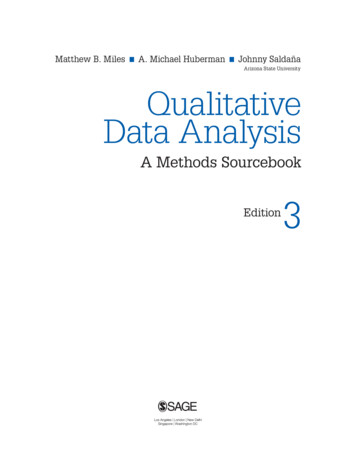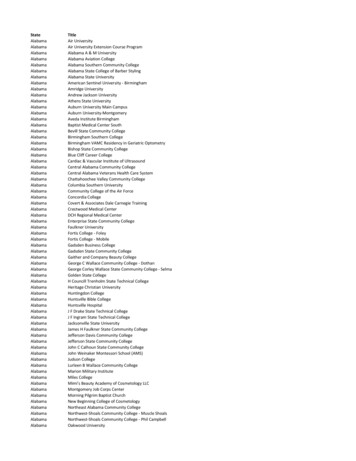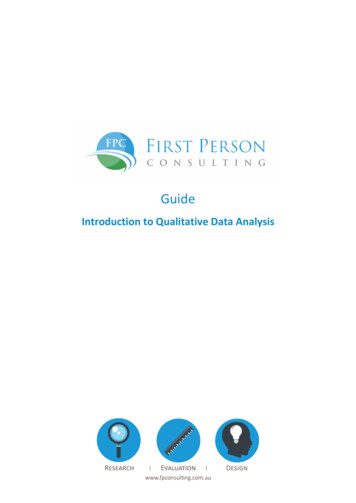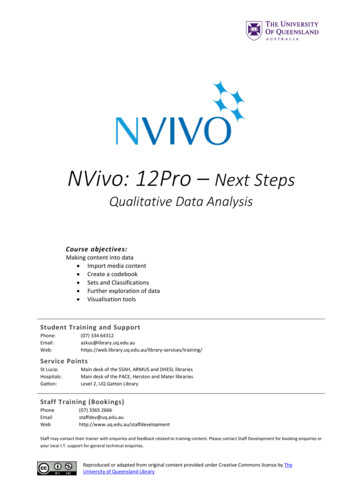
Transcription
Matthew B. Miles A. Michael Huberman Johnny SaldañaArizona State UniversityQualitativeData AnalysisA Methods SourcebookEdition3
Brief Table of ContentsList of DisplaysxiiiPreface to the Third Edition by Johnny SaldañaxviiAcknowledgments From the Second Editionby Matthew B. Miles and A. Michael HubermanAbout the AuthorsxxixxiiiPart One – The Substantive Start . . . . . . . . . . . 1Chapter 1 - Introduction3Chapter 2 - Research Design and Management17Chapter 3 - Ethical Issues in Analysis55Chapter 4 - Fundamentals of Qualitative Data Analysis69Part Two – Displaying the Data. . . . . . . . . . . 105Chapter 5 - Designing Matrix and Network Displays107Chapter 6 - Methods of Exploring121Chapter 7 - Methods of Describing161Chapter 8 - Methods of Ordering193Chapter 9 - Methods of Explaining221Chapter 10 - Methods of Predicting255Part Three – Making Good Sense. . . . . . . . . 273Chapter 11 - Drawing and Verifying Conclusions275Chapter 12 - Writing About Qualitative Research323Chapter 13 - Closure339Appendix – An Annotated Bibliography of Qualitative Research Resources345References363Author Index369Subject Index373
5Designing Matrix andNetwork DisplaysChapter SummaryThis chapter provides fundamental principles for the design and content of twoanalytic display methods: (1) matrices and (2) networks. These methods condense themajor data and findings from a study to further analyze and/or to represent and presentthe conclusions.ContentsIntroductionDisplay Format OptionsMatricesNetworksTiming of Display DesignFormatting the Matrix TemplateEntering Matrix and Network DataMaking Inferences and Drawing Conclusions From Matrices and NetworksThe Methods ProfilesClosure and TransitionChapter 5 Designing Matrix and Network Displays107
IntroductionLengthy, unreduced text in the form of interview transcripts, field notes, documents,and so on is cumbersome because it is dispersed over many pages and is not easy to seeas a whole. It is sequential rather than simultaneous, making it difficult to look at twoor three variables at once. Comparing several extended texts carefully is very difficult.It is usually poorly ordered, can get very bulky, and can make us feel monotonouslyoverloaded. The same objections apply with even stronger force for readers of our finalreports. They need, if not deserve, a concise delivery of what we analyzed. And inthis highly visual culture, showing rather than telling can make a more effective andmemorable impact on our audiences.A major purpose of this text is to encourage the creation and dissemination ofmatrix and network displays for qualitative data. The central argument of this book is“You know what you display.” Credible and trustworthy analysis requires, and is drivenby, displays that are focused enough to permit a viewing of a full data set in the samelocation and are arranged systematically to answer the research questions at hand. A“full data set” does not, of course, mean the complete corpus of interview transcripts,field notes, documents, and so on. Rather, the condensed, distilled data presented aredrawn from the full range of persons, events, and processes under study. With extendedtext, there can easily be “selective stacking” of the data. An organized display wards offthis problem.The idea of display is central to this book. By “display” we mean a visual formatthat presents information systematically so the user can draw conclusions and takeneeded action. Although such displays may sometimes be busy, they will never bemonotonous. Most important, the chances of drawing and verifying conclusions aremuch greater than for extended text, because the display is arranged coherently topermit careful comparisons, detection of differences, noting of patterns and themes,seeing trends, and so on.Quantitative researchers have software packages that can develop publishabletables, graphs, and charts. Qualitative researchers have CAQDAS programs for ourunique approaches to data analysis. And even basic Microsoft Office programs suchas Word and Excel are sufficient for most matrix and network displays. But thequalitative analyst has to handcraft appropriate data display formats because eachproject is unique. As yet, there are few familiar, agreed-on data setups among qualitativeresearchers, so each analyst has to adapt those of others or invent new ones. The displayideas we offer in this book are nothing more than that—ideas, not prescriptions, forqualitative data display.Not everyone loves matrices and network displays—and not everyone thinksvisually. But displaying your condensed data in a systematic way has immenseconsequences for your understanding. It requires you to think about your researchquestions and what portions of your data are needed to answer them; it requires youto make full analyses, ignoring no relevant information; and it focuses and organizesyour information coherently. These advantages are repeated when you includedisplays in a final report; the reader can re-create your intellectual journey with someconfidence.108Part II: Displaying the Data
Display Format OptionsDeciding on and generating the format for displaying qualitative data are importantfirst steps. Your template is a visual outline, of sorts, for the data to be filled in. Formatscan be as varied as the imagination of the analyst, but the ones described in this booktend to fall into two major families:1. Matrices, with defined rows and columns2. Networks, a series of nodes with links (lines and arrows) between themData entries, however, are multiform: short blocks of text, quotes, phrases, variablelabels, ratings, abbreviations, codes, categories, symbolic figures, labeled lines (dashedor solid), arrows (one way or two way), and so on.The display format and content of the entries will depend on what you are trying tounderstand: a general situation, detailed chronologies, the actions of people in differentroles, the interplay of variables, and so on. In other words, form follows function:Formats must always be driven by the research questions involved and your developingconcepts. Formatting determines which variables will be analyzed in which ways. If avariable isn’t included in the format, it won’t get compared with another variable.And it depends on how far along you are in the study and what has priority rightnow. The need might be for eyeballing data in an exploratory way. Or it could be forcarrying out detailed analyses; for setting up data to use in another, more differentiateddisplay; for combining parallel data for a single case; for combining data from severalcases; or for reporting findings. A good format will allow all of these uses to some degreebut inevitably will do some well and others less well.Let’s examine the two major families of displays with examples and illustrations.MatricesA matrix is essentially the “intersection” of two lists, set up as rows and columns. Let’stake a look at a sample format, explaining and labeling it as we go.Display 5.1, a table drawn with Microsoft Word software, is aimed at understandingthe effects of assistance supplied to a school site—the Masepa Case—by varioussources. This was part of a school improvement study that observed how a new projectinnovation was implemented. The matrix format calls for the researcher to address fiverelated variables, to distinguish two of them according to time, to pool responses, toalign some responses along an evaluative scale, and to explain the response patternfor each type of assistance source. Here, condensed information from 30 pages of fieldnotes has been packed into a single page.Note that the data are abstractions: There are no quotes, and generalizations andother inferential remarks appear in the last two columns. The Longer-Run Consequencesand Researcher Explanations are not direct condensations of participants’ remarks orof researchers’ observations. Rather, for any given consequence, such as the one in thetop row (“Users are helped administratively and substantively, feel obliged to do ECRI[Exemplary Center for Reading Instruction] with minor adaptations”), the researcherChapter 5 Designing Matrix and Network Displays109
110Part II: Displaying the Data1. comparing practices withothers2. debugging, complaining3. learning about new parts4. encouragement1. sharing materials2. exchanging tips, solutions3. comparing, encouraging1. tips for presentations2. solution to short-termproblems3. encourages4. serves as successful model 1. facilitates practice2. helps expand beyond coreformat3. maintains effort4. stimulates1. increases stock2. new ideas, practices; problemssolved3. motivates, stimulates2. cathartic, solves short-runproblems3. expands repertoire4. gets through rough moments1. encourages, regulates1. reduces effort, increasesrepertoire2. trains, facilitates use3. problems solved rapidly4. maintains level of effort5. ambivalent: helped yet coerced1. pressures non-users2. building administrators havematerial, administrativesupport1. relieves pressure, encourages2. helps early implementation3. feeling policed4. feeling backed-up,substantially helpedShort-Run Effects(User’s ‘State’)reliable, unthreateningbackup provided in schoolincreases commitment,regulates use (decreasesdeviance)creates reference group,gives users a voice, solvesongoing problems andlowers anxietynew, experienced usersreceive systematicinstruction, follow-up,materials; stay withprogram and are carefulabout making changes in itprogram is perceivedas supported, assisted,‘protected’ by centralofficeusers are helpedadministratively andsubstantively, feel obligedto do ECRI with minoradaptationsLonger-RunConsequencesSource: Miles, M. B., & Huberman, A. M. (1994). Qualitative data analysis: An expanded sourcebook (2nd ed.). Thousand Oaks, CA: Sage Publications.Legend veryeffective effective mixedeffective– ineffectiveTrainers inTarget School,Other SchoolTeacher-Users inOther Schools:Target Schools 2.3.4.5. User-HelpingTeacherMeetings1. provides materials Helping Teacherdemonstrates, modelsanswers requestsencouragescirculates, controls1. promotes ECRI2. answers buildingadministration, trainers’requests Central OfficeAdministrationauthorizes changeseases schedulescontrols fidelityconsults, offers solutions1.2.3.4.Types Provided fects Matrix: Assistance Location and Types (Masepa Case)Display 5.1elaborate and effectivelateral network: trainersseen as peersadditional source ofassistance, which increasesas number of users growsmulti-purpose forum whichconsolidates use and users,defuses oppositionpersonalized in-servicemechanism, with bothtraining and assistanceallows for mastery andspread of ECRI in ‘faithful’formatcentral office able to pushprogram and answerrequests, yet not perceivedas main actor by usersadministration, authority,servicing, availability andflexibility lead to sustained,faithful implementationmodelResearcher Explanations
has looked at the data segments in the three preceding columns, checked to seewhether they covary in some patterned way, and drawn a second-order generalization.In this case (see the first row, first column—Building Administration), themes such as“Eases schedules,” “Consults, offers solutions,” “Relieves pressure, encourages,” “Helpsearly implementation,” and the Users’ Assessment of generally positive magnitude codesall suggested the reception of help and a sense of user obligation for reasonably faithfulimplementation. A similar process of inductive inference occurs under ResearcherExplanations.Overall, the matrix is a tabular format that collects and arranges data for easy viewingin one place, permits detailed analysis, and sets the stage for later cross-case analysiswith other comparable cases or sites. As the chapters progress, you’ll learn how matricescan order data by case or time and can arrange and stack their cells in such a way asto create meta-matrices, which contain multiple rows within a single row and multiplecolumns within a single column.NetworksA network is a collection of nodes or points connected by links or lines that displaystreams of participant actions, events, and processes. Networks lend themselves wellto a case-oriented approach that re-creates the “plot” of events over time, as well asshowing complex interrelationships between variables. They give us the kinds ofnarratives that tend to get chopped up analytically in matrices. They are very helpfulwhen you want to focus on multiple variables at the same time for readily analyzableinformation at a glance.Display 5.2 is a network model from McCammon et al.’s (2012) study of how highschool speech classes influenced and affected adolescents and their adulthood aftergraduation. The network is an outline of “plot points” for an accompanying researchnarrative.Display 5.2A Network Model of “Lifelong Impact” From High School Speech ParticipationAdolescentsFriendshipsAcceptanceand Sense ofBelongingPositiveAffectsAdolescentand AdultConfidenceSource: Saldaña, J. (2013). The coding manual for qualitative researchers (2nd ed.). Thousand Oaks, CA: SagePublications.Chapter 5 Designing Matrix and Network Displays111
The proverb of this research story—the theory—suggested by the oval nodes is asfollows: When Adolescents enroll in high school Speech Classes, they gain Confidenceas an Adolescent and Adult. But that story line is too thin and needs to be fleshedout through an analytic narrative. The rectangular nodes attached to Speech Classesindicate that the classroom content must be led by a teacher who provides GoodCoaching. Students must also feel that they are part of a classroom community througha Sense of Belonging.Not all but some students from those classes participated in extracurricularspeech tournaments or forensic Competitions (debate, extemporaneous speaking,oral interpretation of literature, etc.). Thus, a separate trajectory or stream is drawn.Respondents testified that participation in these events developed Friendships, a senseof Acceptance and Status, and thus Positive Affects, especially for those who reached theachievement of Winning at these competitive events. Regardless of whether one won ornot, the respondents’ stated outcome was Confidence—both as an Adolescent and lateras an Adult.The bidirectional arrow between Speech Classes and Adolescent and Adult Confidencesuggests a cyclical or interactive effect: The more speech classes you took, the moreconfident you became; the more confident you became, the more likely you continuedparticipating in speech classes and competitions.Networks are also effective heuristics for higher level analyses such as discerningcausation, analyzing longitudinal trends, and developing hypotheses and theories.They are not any easier or harder to construct than matrices—both display forms takecomparable amounts of time and thought to design and assemble. Selected CAQDASprograms, however, can greatly assist with complex network construction. Display 5.3illustrates QDA Miner 4’s ability to “calculate” and assemble a three-dimensional networkof codes as weighted nodes, with links suggesting interrelationship. These graphics areextremely helpful as diagnostics of data analysis in progress and as displays themselvesfor final reports.See Knowlton and Phillips (2013) for a diverse collection of logic model graphicdesigns and the online Periodic Table of Visualization Methods for additional ideas(http://www.visual-literacy.org/periodic table/periodic table.html).Timing of Display DesignWhen should display formats be generated? Analytic displays can be developedeither during or after data collection. They can provide preliminary findings aboutwhat is happening in the case and suggest leads toward new data. Later, as fuller, morecomplete descriptions are at hand, these displays can supply the basic material forhigher level explanations—that is, plausible reasons for why things are happening asthey are.If the format is at hand during data collection, it helps save energy by encouragingfocus: You know what information you will be needing. But there are some cautionshere. First, qualitative data evolve; later accounts round out, qualify, put in perspective,and disqualify the earlier ones. Analysts scout around, sleuth, and take second and thirdlooks. So there are risks in entering the data into a set format too soon.112Part II: Displaying the Data
Display 5.3A QDA Miner 4 3-D Map of a Codes NetworkSource: Courtesy of Provalis Research, www.provalisresearch.com.Furthermore, for any given research question or issue, you can develop manydifferent displays (literally dozens) using the same set of variables. Each display makessomewhat different assumptions; each has trade-offs among advantages and costs.Another caution is that display formats nearly always evolve, too. The later ones aremore data sensitive than the earlier ones, as things become clearer.So our general advice is to generate rough formats early during data collection andrevise them to a firmer state closer to the end of data collection, when they can begrounded more contextually and empirically. Expect to make several passes or iterationsbefore the first format of the display is working right. Test a proposed format by enteringdata. Unworkable or confusing formats, or those that do not incorporate all of therelevant data, will show themselves rapidly.Formatting the Matrix TemplateThere are no fixed canons for constructing a matrix. Rather, matrix constructionis a creative yet systematic task that furthers your understanding of the substance andmeaning of your database, even before you begin entering information. Thus, the issueis not whether you are building a “correct” matrix but whether it is a helpful one thatChapter 5 Designing Matrix and Network Displays113
will give you reasonable answers to the questions you are asking or suggest promisingnew ways to lay out the data to get answers. At a deeper level, the message of this bookis not “Use these matrices” but “Think display. Adapt and invent formats that will serveyou best.”Given these choices, what can we say informally about the best and easiest ways tobuild the templates/outlines/frameworks of matrix displays? We state these briskly, asfriendly advice rather than as harsh prescription: Look at your research question(s) and key variables, and think of the data thatare or will be available. Sketch the matrix outline roughly using paper andpencil. Get a colleague to look at your initial format, to help you detect the assumptionsyou are making and to suggest alternative ways to display your data. Set up the matrix template by using a text program, database management,or CAQDAS software. Try to make the display completely readable on yourmonitor screen or on one printed sheet of paper, if possible. You have to beable to see it all at once. Don’t try to include more than a dozen or so variables in rows or columns; five orsix is more manageable. If you are drawn to a design with larger numbers ofvariables, plan to cluster or partition them as meta-matrices. In effect, regroupthe matrix into “streams” or adjacent “families.” The simplest matrices are organized in two dimensions. You have a choice tomove to more complexity if the data demand it by creating partitions for metamatrices—rows within a row and/or columns within a column (to be illustratedin forthcoming chapters). If the matrix is an ordered one, expect to transpose rows and columns for awhile until you have a satisfactory version. Most text-based software, databasemanagement, and CAQDAS programs can do this quite easily. Always stay open to the idea of adding new rows or columns, even late in youranalysis operations. Keep rows and columns fine grained enough to accommodate meaningfuldifferentiations in the data but not so fine as to bury you under indiscriminatedetail. Keep in mind that any particular research question may require a series ofdisplays; for example, an initial partially ordered descriptive matrix maylead to a small summary table and then to a network display. Think aheadto this possibility, but allow new matrix forms to emerge as the analysisproceeds.Creating matrix templates is usually a matter of a few minutes; revising them as theearly items of data are entered is also quick work. Virtually all CAQDAS programs canenable reformatting as data are entered and coded. The time taken to enter data into adisplay actually depends on the following: (a) the number of variables or dimensions inthe display, (b) the number of respondents and cases, and (c) the kind and number oftransformations made.114Part II: Displaying the Data
Which types of row and column headings or network bin labels are possible?The set is almost infinite, ranging from cases to variables. To illustrate, here is just asample of types adapted from Gobo (2008), Lofland, Snow, Anderson, and Lofland(2006), and Bogdan and Biklen (2007). For concreteness, we use examples fromhealth care settings:Individuals:Jane Hughes, RN, Dr. Luis GarciaRoles:patients, nurses, doctors, administratorsRelationships and groups:patient–spouse, nurse–resident, intensivecare unit staff, accounting department,surgical teamSettings within sites:operating room, emergency room, cafeteriaSites as wholes:Good Samaritan Hospital, downtownhealth maintenance organizationSpecific actions (what people do and say):diagnostic questions, answers, listening,information giving, comfortingEvents (marked-off happenings oroccurrences):admission, operation, dischargeActivities (regularly occurring, connectedsets of actions):grand rounds, lab tests, billingStrategies (activities aimed toward somegoal):rehabilitation plan, nutrition counseling,radiation treatmentMeanings and perspectives (how peopleconstrue events):patient and physician views of an HIVpositive diagnosis, the experience of laborand childbirthAttitudes, values, and beliefs:resentment toward physician seniority,pro-choice versus pro-life, patient anxietyEmotions and states:staff morale, patient fear, critical conditionProcesses (ongoing flows, phases, stages,cycles, changes over time):wound healing, convalescence, triage,decision making, social support,bereavementEntering Matrix and Network DataGenerally, the choice of data for display entry must be driven by the particular rowand column headings involved or by your definitions of network nodes and links. Butthese seemingly straightforward tasks are critical issues in qualitative data analysis. Theconclusions drawn from a display can never be better than the quality of the data entered.A completed matrix or network may look coherent, plausible, and fascinating, but if thedata were poorly collected in the first place or were entered in a hasty, ill-partitioned, orvague way, the conclusions are suspect. We offer some guidelines below for data entryinto display formats:Chapter 5 Designing Matrix and Network Displays115
Even a dense matrix displays only a very small percentage of the available data.There is always a great deal of selection and condensation from the mass of fieldnotes. Be aware of how you make that selection and how you boil the datadown. You are not throwing away your field notes—you can always refer backto the full material. More information is better than less: Too thin cell entries keep you away from themeaning of the data. Be clear about the forms and types of data you want to enter: direct quotes,paraphrases, general summary judgments, ratings, and so on. Use codes and software search functions to locate key material. Entering thesedata is much easier with text-based software, database management, or aCAQDAS program having multiple screens; they permit you to retrieve codedchunks to one screen or region and to select/edit/condense them on another. Keep an explicit record of the “decision rules” you followed in selecting datachunks for entry (e.g., the extent of agreement among respondents or datatypes, the intensity of respondents’ feelings, the basis for making judgments orratings). Otherwise, you may delude yourself retrospectively, forget how you didit, or shift your decision rules during the process. When data are missing, ambiguous, or were not asked for from certain respondents,show this explicitly in the display. Don’t lock up your format until later in the process. Entering data tests the adequacy,realism, and helpfulness of the display format. Keep revising it as needed. Be open to using numbers, direct quantities, or judgments in the form of ratings,scales, or magnitude codes, when applicable to the study. Get a colleague to review your display, along with your decision rules andwritten-up field notes, to check the procedural adequacy of your work. Suchaudits are time-consuming, but used selectively, they are an important check onthe “confirmability” of the procedures you used.You always have choices about the level and type of data to be entered. For example,you can include the following:116Direct quotes, extracts fromwritten-up field notes:“Surgeons are basically macho types—the best ones, Imean. They have to be, but they can’t help it.”Summaries, paraphrases, orabstracts:Patient advocate seems increasingly distrusted. Rules forresidents’ time use largely ignored.Researcher explanations:Patient uncertainty about diagnosis is a function of lifethreatening conditions and use of denial as a buffer.Ratings or summarizedjudgments:Risk reduction behavior after cardiovascular bypass:worse, no change, improved, much improved.Combinations of the above:Risk reduction: improved. Diet (“I even tried broccoli”),some exercise (walks 20–30 minutes daily), and smoking(reduced, is considering using a nicotine patch).Part II: Displaying the Data
Making Inferences and Drawing ConclusionsFrom Matrices and NetworksThe test of any display is what it helps you understand—and how trustworthythat understanding is. In the next five chapters, there will be many specific tactics forconclusion drawing and verification through the use of boldface. Each has its specificadvantages and pitfalls, which we will discuss in Chapter 11. Here, we offer somepreliminary general advice: It’s always helpful to start with a quick scan—a “squint analysis” or “eyeballing”down columns and across rows and through network pathways to see whatjumps out. Then, verify, revise, or disconfirm that impression through a morecareful review. Any given display will always have multiple tactics used on it. The ones wehave used most frequently for drawing first conclusions are noting patterns,themes; making contrasts, comparisons; clustering; and counting. Displays never speak for themselves—either to you or to the reader;accompanying text is always needed. As conclusions form in your mind, alwayswrite text explaining them. Make your conclusions explicit. The process ofwriting inevitably leads to reformulation, added clarity, and ideas for furtheranalysis. Writing is itself a form of analysis. First conclusions drawn from a display almost always need to be checkedagainst written-up field notes. If a conclusion does not ring true at the “groundlevel” when you try it out there, it needs revision. Look at the raw data toguard against this. Even better, check with your research colleagues and theparticipants themselves, when possible. Any early conclusion typically needs confirmation, checking, and verification.The most frequently used tactics we’ve used are as follows: following upsurprises, triangulating, making if-then tests, and checking out rivalexplanations. Be sure your descriptive understanding is clear at the individual or within-caselevel first before you try to understand cross-case patterns. Remember that analysis usually has to go beyond descriptive summation and reachtoward explanation. Clarify the conceptual implications of your conclusions—that is, how they tie into your or someone else’s theory of social behavior.Analyses that yield verifiable but poor-meaning conclusions are of little use toanyone.Conclusions about data displays normally appear in what we call an analytic textor narrative. Analytic narrative draws attention to the features of the displayed dataand makes sense of them, knitting them together and permitting the analyst to drawconclusions and add interpretations. It also encourages a return to the field notes toconsult information not in the display and to add it to the text for further clarity. Sincea display does not speak for itself, analytic text does not stand alone without referenceto the display.Chapter 5 Designing Matrix and Network Displays117
In fact, the act of writing text as you ruminate over the meaning of a display is itselfa focusing and forcing device that propels further analysis. Writing does not come afteranalysis; it is analysis, happening as the writer thinks through the meaning of data in thedisplay. Writing is thinking, not the report of thought.Stay open on the question of whether the display format you use for analysis shouldbe the same display used for final reporting (the answer is often “yes”). Readers can seefor themselves how conclusions were drawn, rather than being handed summarizedstudy results to be taken on faith. Sometimes, of course, a display will be used forintermediate purposes and will not necessarily be shown to readers of the final report.The tradition of presenting basic data is deeply ingrained in reports of quantitativedata analysis, so much so that it would be unthinkable for a researcher to presentconclusions without data tables or, at least, without reference to working documentscontaining them. We believe that the same norms should apply to qualitative researchersworking within particular traditional genres of inquiry (e.g., ethnography, groundedtheory, content analysis, evaluation research, etc.). Some data displays should be anormal part of reporting fi
tables, graphs, and charts. Qualitative researchers have CAQDAS programs for our unique approaches to data analysis. And even basic Microsoft Office programs such as Word and Excel are sufficient for most matrix and network displays. But the qualitative analyst has to handcraft appropriate data










